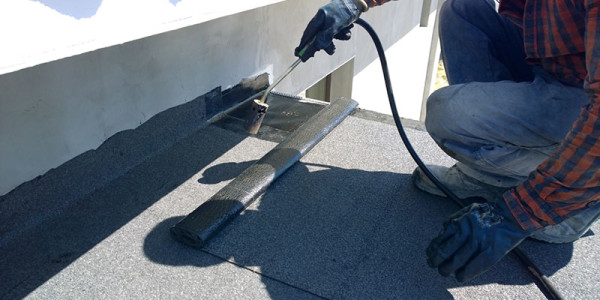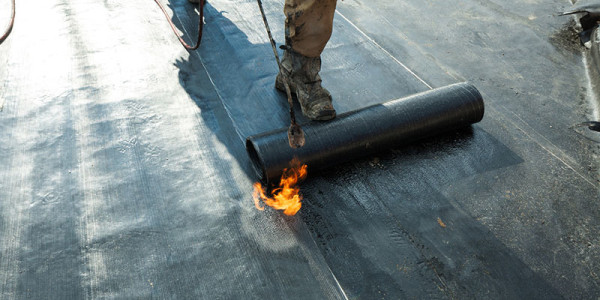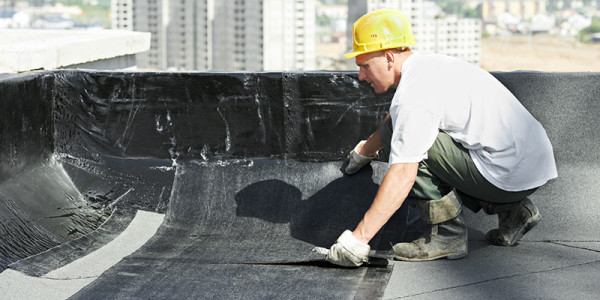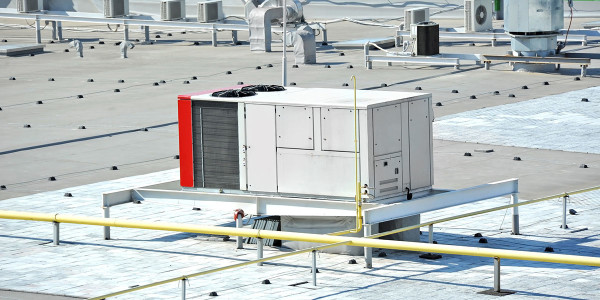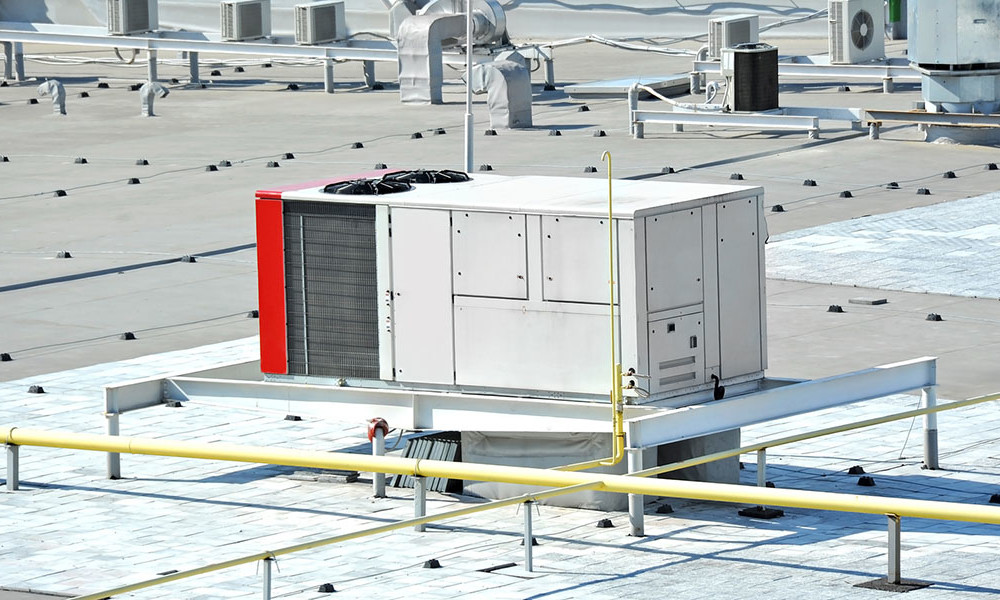
Types of Commercial Roofs we Service and Replace
Modified bitumen
A bitumen is a term applied to both coal tar pitch and asphalt products. Modified Bitumens were developed in Europe in the 1970s when Europeans became concerned with the lower performance standards of roofing asphalt. Modifiers were added to replace the plasticizers that had been removed by advanced methods in the distillation process. The two most common modifiers are APP (atactic polypropylene) from Italy and SBS (styrene-butadiene-styrene) from France. The United States started developing modified bitumen compounds in the late 1970s and early 1980s.
APP was added to asphalt to enhance aging characteristics and was applied to polyester, fiberglass, or polyester and fiberglass membranes to form a sheet good, cut in manageable lengths for handling. Usually applied by heating up the underside of the roll with a torch provided a significant fire hazard and was outlawed in some municipalities when buildings caught fire and some burnt to the ground. Another problem developed when a lack of standards allowed some manufacturers to produce goods with amounts of APP insufficient to enhance the aging characteristics.
SBS is used as a modifier for enhancing substandard asphalt and provides a degree of flexibility much like rubber. It also is applied to a myriad of carriers and produced as a sheet-good in rolls that can be easily handled.
SEBS – (styrene ethylene butadiene styrene) is a formulation increasing flexibility of the sheet and longevity.
Cold applied liquid membranes
A choice for new roofs and roof refurbishment. This type of a roof membrane is generally referred to as Liquid Roofing and involves the application of a cold liquid roof coating. No open flames or other heat sources are needed and the glass fiber reinforced systems provide seamless waterproofing around roof protrusions and details. Systems are based on flexible thermoset resin systems such as polyester and polyurethane, and poly-methyl-methacrylate (PMMA). In the United Kingdom, liquid coatings are the fastest growing sector of the flat roof refurbishment market. Between 2005 and 2009 the UK’s leading manufacturers have reported a 70% increase in the roof area covered by the coating systems supplied.[6] Cold applied liquid rubber offers similar benefits to thermoset resin systems with the added benefit of being quick to apply and having high elasticity. Although it is comparatively new to the UK market it has been used successfully in the US market for 20 years.
PVC (vinyl) membrane roofing
Polyvinyl Chloride (PVC) membrane roofing is also known as vinyl roofing. Vinyl is derived from two simple ingredients: fossil fuel and salt. Petroleum or natural gas is processed to make ethylene, and salt is subjected to electrolysis to separate out the natural element chlorine. Ethylene and chlorine are combined to produce ethylene dichloride (EDC), which is further processed into a gas called vinyl chloride monomer (VCM). In the next step, known as polymerization, the VCM molecule forms chains, converting the gas into a fine, white powder – vinyl resin – which becomes the basis for the final process, compounding. In compounding, vinyl resin may be blended with additives such as stabilizers for durability, plasticizers for flexibility and pigments for color.
Thermoplastic is heat-welded seams form a permanent, watertight bond that is stronger than the membrane itself. PVC resin is modified with plasticizers and UV stabilizers, and reinforced with fiberglass non-woven mats or polyester woven scrims, for use as a flexible roofing membrane. PVC is, however, subject to plasticizer migration. (a process by which the plasticizers migrate out of the sheet causing it to become brittle.) Thus, a thicker membrane has a larger reservoir of plasticizer to maintain flexibility over its lifespan. PVC is often blended with other polymers to add to the performance capabilities of the original PVC formulation, such as KEE – Keytone Ethylene Ester. Such blends are referred to as either a CPA – Copolymer Alloy or a TPA – Tripolymer Alloy.
Vinyl roofs provide an energy-efficient roofing option due to their inherently light coloring. While the surface of a black roof can experience a temperature increase of as much as 90 degrees under the heat of the full sun, a white reflective roof typically increases only 5–14 degrees Celsius (10–25 degrees Fahrenheit).
Vinyl membranes can also be used in waterproofing applications for roofing. This is a common technique used in association with green, or planted, roofs.
FTPO
Flexible Thermo Polyolefin– correct acronym for the product TPO “Flexible”-retains flexibility “Thermo”-can be reheated again and again, does not cure”. “Polyolefin”-a polymer produced from a simple olefin. Flexible Thermo Poly-Olefin is the exact physical and chemical name given to the product “TPO” Thermo Plastic Olefin. Although TPO exhibits the positive characteristics of other Thermo Plastics, it does not however have any “plasticizers” added to the product like other Thermoplastics. This mis-categorization made sense when the product was introduced in the early 1990s and was unproven in the industry. TPO was categorized with Thermoplastic membranes that were similar in look and performance but were far from their real chemical and physical characteristics of the TPO membrane. TPO was formulated to fix all the problems associated with other Thermoplastic membranes. Having no plasticizers and chemically being closer to rubber but having better seam, puncture, and tear strength, TPO was touted to be white weldable rubber of the future. From 2007-2012 reported sales of TPO roofing products by all six major U.S. manufacturer’s report materials and accessories sales quadrupling all other flat roofing materials. Gross sales of TPO membrane roofing in U.S. exceeds all other flat roof types combined. TPO’s rapid market acceptance over the last twenty years by contractors, architects, engineers, and the market in general shows it is living up to its original purpose and it’s here to stay.
TPO is also being touted as the green solution as it is safer for installers and recycles 100% without chemical byproduct.
Flexible Thermo Polyolefin will soon replace the Thermo Plastic Polyolefin as the correct abbreviation for the TPO membrane roofing category.
Coal-tar pitch built up roof
Coal tar pitch is a carcinogen, forbidden by code in some areas. When installing and patching existing coal tar roofs, worker and building occupant exposure should be avoided, or minimized. Coal Tar fumes are hazardous and provisions must be made during the application to prevent fumes from getting into the building. Workers should wear protective equipment and clothing, and commonly get higher compensation (pitch pay) for exposure to the health risks.
Coal tar is an aromatic hydrocarbon and a by-product from the coking process of the coal industry. It is historically in abundance where coal is used in steel manufacturing. It ages very slowly through volatilization and is an excellent waterproofing and oil resistant product. Roofs are covered by heating the coal tar and applying it between layers of tar paper. It has limitations in regards to its application on dead level or flat roofs with slopes less than 1/4 in 12. It has a tendency to soften in warm temperatures and “heal” itself. It is typically ballasted with gravel to provide a walking surface, however a mineral surface membrane is available. Coal tar provides an extremely long life cycle that is sustainable and renewable. It takes energy to manufacture and to construct a roof with it but its proven longevity with periodic maintenance provides service for many years, with ages from 50 to 70 years not uncommon, with some now performing for over a century. Currently, there are cold process (no kettle is used) coal tar pitch products that almost eliminate all fumes associated with its typical hot process version.
Coal tar pitch is often confused with asphalt and asphalt with coal tar pitch. Although they are both black and both are melted in a kettle when used in roofing, that is where the similarity stops.
Cool Roofs
Roofing systems that can deliver high solar reflectance (the ability to reflect the visible, infrared and ultraviolet wavelengths of the sun, reducing heat transfer to the building) and high thermal emittance (the ability to release a large percentage of absorbed, or non-reflected solar energy) are called cool roofs. Cool roofs fall into one of these three categories: inherently cool, green planted roofs or coated with a cool material.
- Inherently cool roofs: Roof membranes made of white or light colored material are inherently reflective and achieve some of the highest reflectance and emittance measurements of which roofing materials are capable. A roof made of thermoplastic white vinyl, for example, can reflect 80% or more of the sun’s rays and emit at least 70% of the solar radiation that the building absorbs. An asphalt roof only reflects between 6 and 26% of solar radiation, resulting in greater heat transfer to the building interior and greater demand for air conditioning – a strain on both operating costs and the electric power grid.[11]
- Green planted roofs: A green roof is a roof that is partially or completely covered with vegetation and a growing medium, planted over a waterproofing membrane. A green roof typically consists of many layers, including an insulation layer; a waterproof membrane, often vinyl; a drainage layer, usually made of lightweight gravel, clay, or plastic; a geotextile or filter mat that allows water to soak through but prevents erosion of fine soil particles; a growing medium; plants; and, sometimes, a wind blanket. Green roofs are classified as either intensive or extensive, depending on the depth of planting medium and amount of maintenance required. Traditional roof gardens, which are labor-intensive and require a reasonable depth of soil to grow large plants are considered intensive, while extensive green roofs are nearly self-sustaining and require less maintenance.
- Coated roofs: One way to make an existing or new roof reflective is by applying a specifically designed white roof coatings (not simply white paint) on the roof’s surface. The coating must be Energy Star rated. Reflectivity and emissivity ratings for reflective roof products available in the United States can be found in the Cool Roof Rating Council website.[12]
Cool roofs offer both immediate and long-term savings in building energy costs. Inherently cool roofs, coated roofs and planted or green roofs can:
- Reduce building heat-gain, as a white or reflective roof typically increases only 5–14 °C (10–25 °F) above ambient temperature during the day
- Enhance the life expectancy of both the roof membrane and the building’s cooling equipment.
- Improve thermal efficiency of the roof insulation; this is because as temperature increases, the thermal conductivity of the roof’s insulation also increases.
- Reduce the demand for electric power by as much as 10 percent on hot days.
- Reduce resulting air pollution and greenhouse gas emissions.
- Provide energy savings, even in northern climates on sunny (not necessarily “hot”) days.
Maintenance and assessment
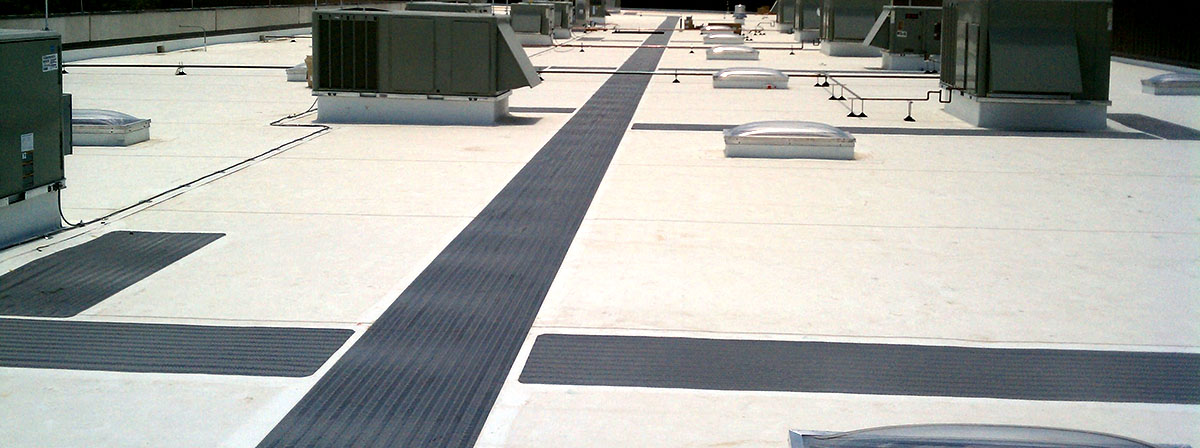
A flat roof lasts longer if it is properly maintained. Some assessors use 10 years as an average life cycle, although this is dependent on the type of flat roof system in place. Some old tar and gravel roofers acknowledge that unless a roof has been neglected for too long and there are many problems in many areas, a BUR (a built up roof of tar, paper and gravel) will last 20–30 years. There are BUR systems in place dating to the early 1900s.[citation needed]
Modern cold applied liquid membranes have been durability rated by the British Board of Agreement (BBA) for 30 years. BBA approval is a benchmark in determining the suitability of a particular fiberglass roofing system. If standard fiberglass polyester resin is used such as the same resin used in boat repairs, then there will be problems with the roof being too inflexible and not able to accommodate expansion and contraction of the building. A fit-for-purpose flexible/elastomeric resin system used as a waterproofing membrane will last for many years with just occasional inspection needed. The fact that such membranes do not require stone chippings to deflect heat means there is no risk of stones blocking drains. Liquid applied membranes are also naturally resistant to moss and lichen.
General flat roof maintenance[10] includes getting rid of ponding water, typically within 48 hours. This is accomplished by adding roof drains or scuppers for a pond at an edge or automatic siphons for ponds in the center of roofs. An automatic siphon can be created with an inverted ring-shaped sprinkler, a garden hose, a wet/dry vacuum, a check valve installed in the vacuum, and a digital timer. The timer runs two or three times a day for a minute or two to start water in the hose. The timer then turns off the vacuum, but the weight of water in the hose continues the siphon and soon opens the check valve in the vacuum. The best time to address the issue of ponding water is during the design phase of a new roofing project when sufficient falls can be designed-in to take standing water away. The quicker the water is got off the roof, the less chance there is for a roof leak to occur.
All roofs should be inspected semi-annually and after major storms. Particular attention should be paid to the flashings around all of the rooftop penetrations. The sharp bends at such places can open up and need to be sealed with plastic cement, mesh and a small mason’s trowel. Additionally, repairs to lap seams in the base flashings should be made. 90% of all roof leaks and failure occur at the flashings. Another important maintenance item, often neglected, is to simply keep the roof drains free of debris. A clogged roof drain will cause water to pond, leading to increased “dead load” weight on building that may not be engineered to accommodate that weight. Additionally, ponding water on a roof can freeze. Often, water finds its way into a flashing seam and freezes, weakening the seam.
For bitumen-based roof coverings maintenance also includes keeping the tar paper covered with gravel, an older method, currently being replaced with bituminous roofing membranes and the like, which must be ‘glued’ in place so wind and waves do not move it causing scouring and more bare spots. The glue can be any exterior grade glue like driveway coating.
Maintenance also includes fixing blisters (delaminations) or creases that may not yet be leaking but will leak over time. They may need experienced help as they require scraping away the gravel on a cool morning when the tar is brittle, cutting open, and covering with plastic cement or mastic and mesh. Any moisture trapped in a blister has to be dried before being repaired.
Roof coatings can be used to fix leaks and extend the life of all types of flat roofs by preventing degradation by the sun (ultra-violet radiation). A thickness of 30 dry mils is usually preferred and once it is fully cured, you will have a seamless, watertight membrane.
Infrared thermography is being used to take pictures of roofs at night to find trouble spots. When the roof is cooling, wet spots not visible to the naked eye, continue to emit heat. The infrared cameras read the heat that is trapped in sections of wet insulation.

